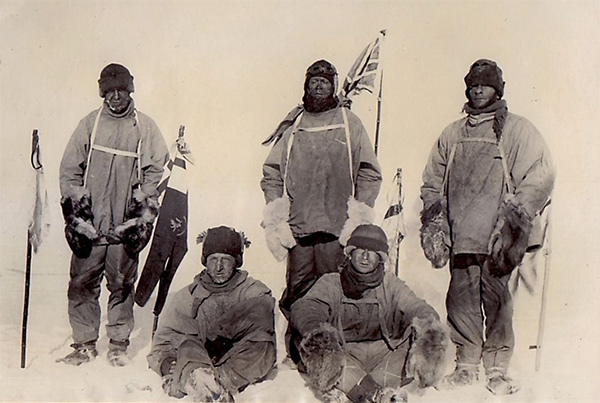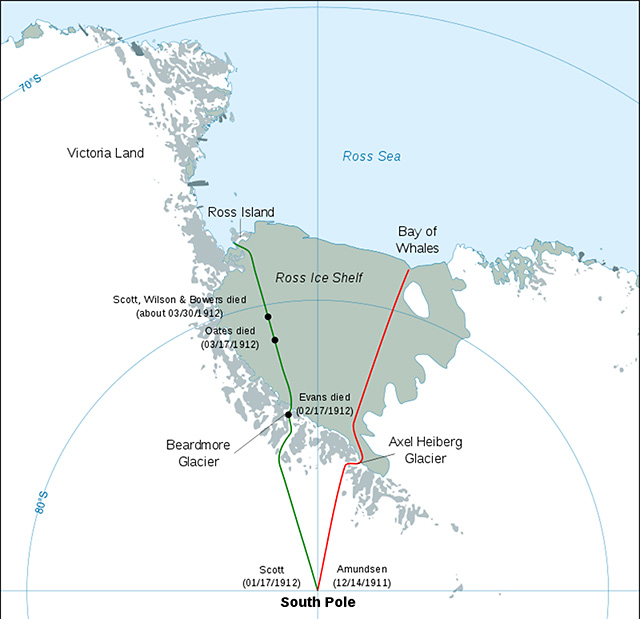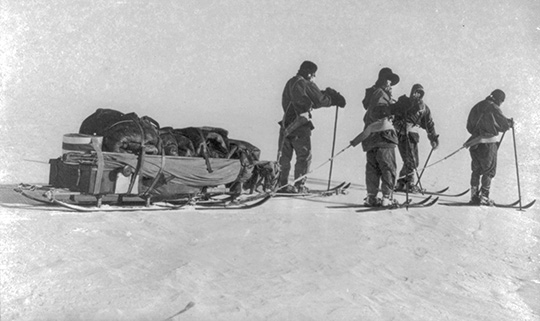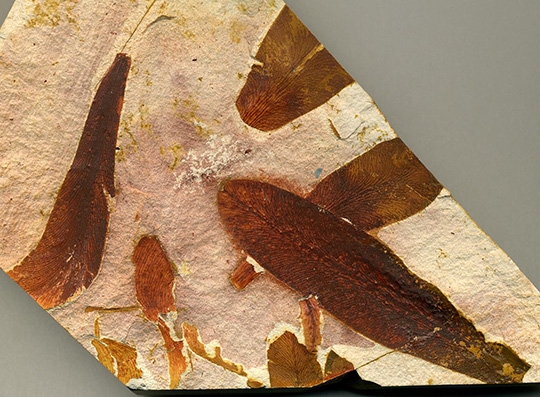
Credit: By Henry Bowers (1883-1912) [Public domain]
In 1911, Robert Scott and Roald Amundsen led expeditions to Antarctica, both hoping to be first to the South Pole.
Amundsen’s crew left 20 days before Scott, using sled dogs.
Scott’s team took a different route, using motorized snow tractors, hoping to speed their passage.
After 77 days, Scott and his men finally reached the pole—only to find that Amundsen had beat them to it.
With great disappointment, they turned back to their ship … when disaster struck.
The temperature plummeted as the Antarctic winter arrived early.
In their journals, they recorded temperatures below -40o Fahrenheit.
Weather kept their base team from provisioning their return depots. Out of fuel, they had to pull sleds with their tents and gear.
In the extreme cold, the ice was no longer slippery—we talked about this in a previous EarthDate.
A layer of water less than one-billionth of a meter thick occurs on the surface of ice down to -36o Fahrenheit.
Below that, the water molecules become pinned to the ice and they no longer slip.
This meant that Scott’s sleds no longer slid, slowing their progress and doubling their exposure to the severe cold.
One by one, the men got frostbite and could no longer travel. Out of options, they made their last camp, wrote farewell letters, and waited for the end.
A trip cut tragically short by the not-so-slippery properties of ice.
Background
Synopsis: In 1911-1912, two Antarctic Expeditions raced to the South Pole, one led by Norwegian explorer Roald Amundsen and the other led by English explorer Robert F. Scott. Both parties reached the pole, but the English team did not make it back. Tragically, the doomed team discovered the point at which ice is no longer slippery, possibly sealing their fate.

- From the time of James Cook in the late 1700s, explorers were interested in the great icy southern continent.
- Many explorers, including Cook, crossed the Antarctic Circle in different expeditions, but the first land sighting—of the South Shetland Islands—wasn’t until 1819.
- The Belgian Antarctic Expedition was the first to winter over on Antarctica in 1897-1899.
- In the first decade of the 1900s, 11 expeditions from European countries and Japan targeted Antarctica, but by 1910, none had reached the South Pole. Two expeditions started out in 1910 with the explicit goal of reaching the pole.
- One was a Norwegian expedition led by Roald Amundsen (who had been a first mate during the previous Belgian expedition).
- The expedition departed from Norway in June 1910 for the North Pole, then changed plans and headed to the South Pole in August, arriving in Antarctica on January 14, 1911.
- They brought a large number of Scandinavian dogs to pull their sleds and dressed in Inuit garments to protect themselves from the cold.
- After spending the Antarctic winter months building a base called Framheim near the Bay of Whales, Amundsen made a first attempt to get to the pole in September but turned back.
- Amundsen and four other explorers departed for the pole a second time on October 20, 1911, cutting across two icy mountain ranges and arriving at the South Pole 55 days later, on December 14, 1911, in the heart of the Antarctic summer.
- It took them 42 days to return to their base at Framheim on January 25, 1912, for a total of 97 days in transit.
- The other expedition was the ill-fated British Antarctic Expedition of 1910 led by Royal Navy Commander of the Victorian Order Robert Falcon Scott. It is also known as the Terra Nova Expedition.
- In 1901-1904, Scott led the Discovery expedition that made it to 82o South latitude, and discovered the Antarctic Plateau, where the South Pole is located, but did not make it to the pole on that journey.
- On June 15, 1910, Scott set sail on the Terra Nova from Cardiff, Wales.
- He and his crew invented and built motorized caterpillar track vehicles for their extreme voyage and brought ponies and dogs for backup.
- After a difficult voyage from New Zealand, including 20 days trapped in pack ice in December 1910, the expedition arrived later than they planned at Cape Evans, 60 mi (100 km) farther from the South Pole than Amundsen’s Framheim base.
- They became aware that Amundsen’s party was nearby but did not have any news of their progress.
- After laying out supply depots and making a failed start in late October, the expedition departed on November 1, 1911, for the pole. The ponies struggled in the extreme cold and most were left behind.
- The expedition reached the South Pole after 77 days, on January 17, 1912, only to find with great disappointment that Amundsen’s team had arrived five weeks earlier and had departed homeward on December 18, 1911.
- The party began the 800-mi (1,300-km) return to Cape Evans on January 19, 1912.

Members of the Terra Nova Expedition at the South Pole. When the temperature dropped too much, the ice lost its slipperiness and the men could hardly budge the sleds they were pulling. Credit: Library of Congress Prints and Photographs Division - They completed 300 mi (480 km) in about 20 days, but lost teammate Edgar Evans on February 17 after he fell during the descent of the Beardmore Glacier.
- With rapidly deteriorating weather, reprovisioning of their supply depots with fuel for their vehicles and food for men and dogs had not occurred.
- On March 2, teammate Lawrence Oates developed frostbite on his toes, slowing the party considerably as he crawled alongside the sledges. He eventually crawled off into a blizzard, unnoticed, to die on March 17.
- On March 10, the men’s journals described temperatures that dropped below -40oF (-40oC) unexpectedly—temperatures that ranged as much as 20oF (11oC) colder than normal as the Antarctic winter set in earlier than usual.
- As they dragged the sledges with their tents, food and supplies back northward, the doomed explorers recorded that the ice surface produced a “thin layer of woolly crystals,” creating “impossible friction on the runners.”
- The increased drag of the incredibly cold ice surface slowed their return progress to less than half of what they experienced on their trip toward the pole.
- Scott’s toes became frostbitten, and they made their final camp on March 19. Tragically they were just 11 mi (18 km) from the largest of their supply depots.
- A fierce blizzard trapped them for nine days, and their supplies ran out, so Robert Scott, Edward Wilson and Henry Bowers wrote farewell letters and final journal entries, the last of which was penned on March 29, 70 days after departing the South Pole.
- The group traveled in extreme conditions for 147 days, 50 days longer than the Norwegians did.
- Polar explorers depended on sledges sliding over the ice to carry their supplies. In a previous EarthDate we explained why ice is so slippery. But there is a point when ice loses its slipperiness.
- Solid water, or ice, is held tightly together by four hydrogen bonds that create a highly structured framework of water molecules. But molecules on the surface of the ice can only make two to three hydrogen bonds, so they become disorganized into a single layer of molecules that act like tiny slippery ball bearings, even at temperatures as low as -36oF (-38oC). This makes ice slippery enough that sledges can move across it easily.
- But what happens at even lower temperatures? The loose surface molecules appear to get pinned down to the surface of the ice, and friction on the surface increases dramatically. The ice is no longer slippery.
- Researchers have recently found that ice’s slipperiness decreases once temperatures drop below -49oF (-45oC), and that ice’s coefficient of friction maxes out around -94oF (-70oC) where it plateaus.

Scott's party found Glossopteris leaf fossils like this one in Antarctica, proving that the continent had once been warm. Credit: James St. John, [CC BY 2.0 (https://creativecommons.org/licenses/by/2.0)] - The increased distance from base to pole for the British Antarctic Expedition and the later season start contributed to a much harder and colder journey than the Amundsen expedition experienced, resulting in extreme fatigue and frostbite.
- The unexpected loss of slipperiness for the ice below the runners of the sledges is believed to have played a major role in slowing the party, resulting in increased exposure and, ultimately, their deaths.
- The first fossils ever discovered on Antarctica had been collected by the explorers and were found next to their bodies. They were 35 lbs (16 kg) of Glossopteris tree fossils the party had dragged on sledges, proving that Antarctica had once been warm enough to support large plants like trees.

